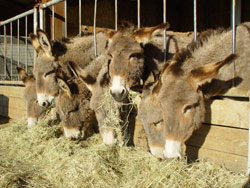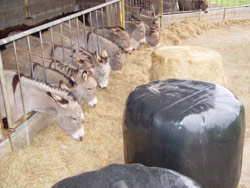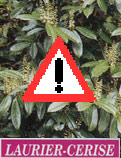|
Food

The donkey eats grass, but it enjoys thistles: its
favourite menu.
You will also see it eating nettles, but contrary
to the thistles, it cuts them at the level of the roots when they
start to turn dry.
It is also an excellent "hedge trimmer" who will
not neglect fibrous brambles, branches and all plants.
In Normandy, its principal food will be of course
a good grass during two-thirds of the year.
If you need to contribute fertilizer to your ground, be careful
to not put too much nitrogen. Do not hesitate to ask for information
in an agricultural store, about the proportioning advised for equidaes.
 |
When the grass is too tender or too wet, it is better
to give them hay in their rack for their intestinal balance.
In the winter, the hay will be its principal food. But be
careful do not overfeed your donkey except if is working (attachment,
excursion...), or in period of covering for the stallions.
|
 You
should not give food to the hand such as bread, carrots, delicacies,
etc... The donkey will become vicious, and lead it to bite, which
is completely contrary to its practices if it has a good education. You
should not give food to the hand such as bread, carrots, delicacies,
etc... The donkey will become vicious, and lead it to bite, which
is completely contrary to its practices if it has a good education.
Having an important breeding, I have used for about
fifteen years a cover for the hay which is a special wrapping to
keep it dryed, it is hay dry in a traditional way, put in rolls
(approximately 300kg) and then cover with a minimum of four layers
of plastic film to create a vacuum seal.
This method has the advantage of preserving all the
qualities in the hay, to be very appetizing and to allow very easy
storage outside.
When it is open, it is better to be consumed within three days so
as not lose its qualities (goodness).
This system requires only a little labour but can be used only for
breedings with ten donkeys or more.

The donkey, like the human needs minerals. Also, it
will be necessary to add to the contribution of vitamins
in the form of stone's to be licked.
To prevent the donkey from attacking the bark on the trees, it is
desirable to also place a selenium stone at their disposal.
These food complements are sold in the agricultural
cooperatives or in stores specialized for equidaes.

Be careful, certain plants or trees can be toxic. For more information,
there is an article published in Poneyscope December 1995 written
by Charles Desjardins presenting the principal toxic plants for
equidaes:
POISONOUS PLANTS
|










